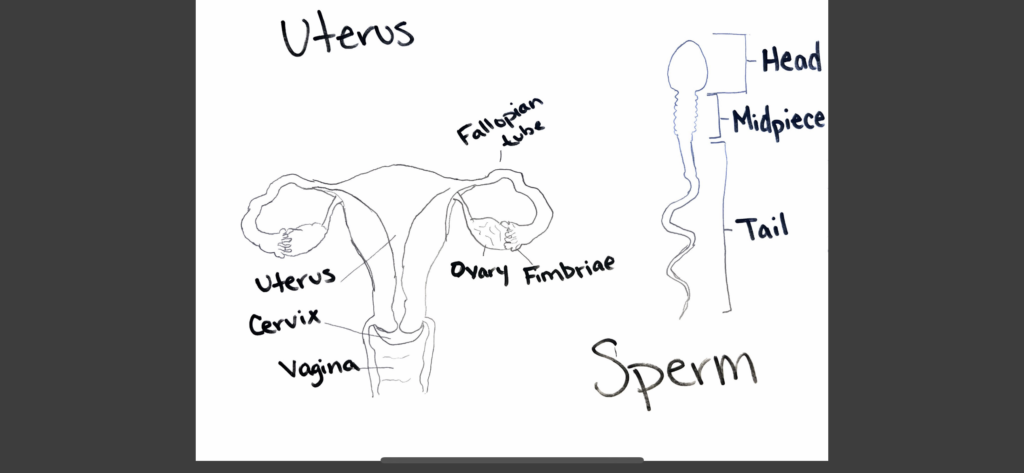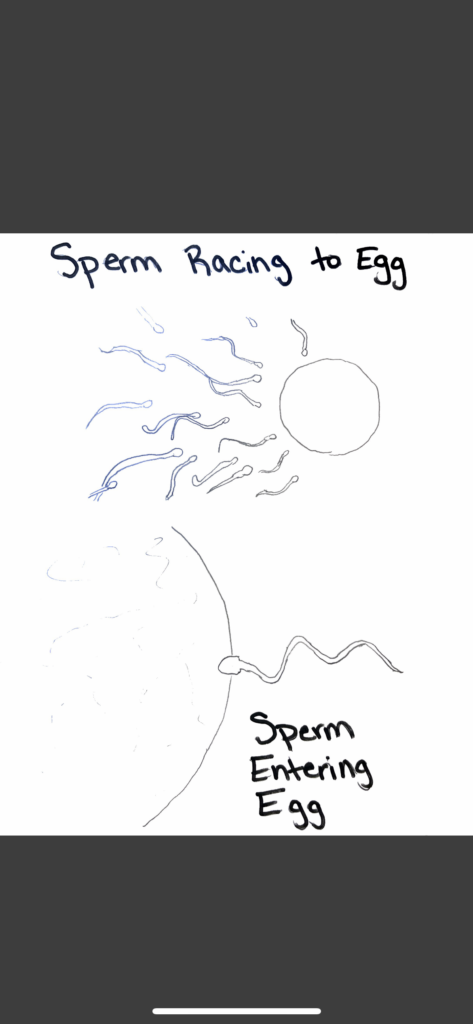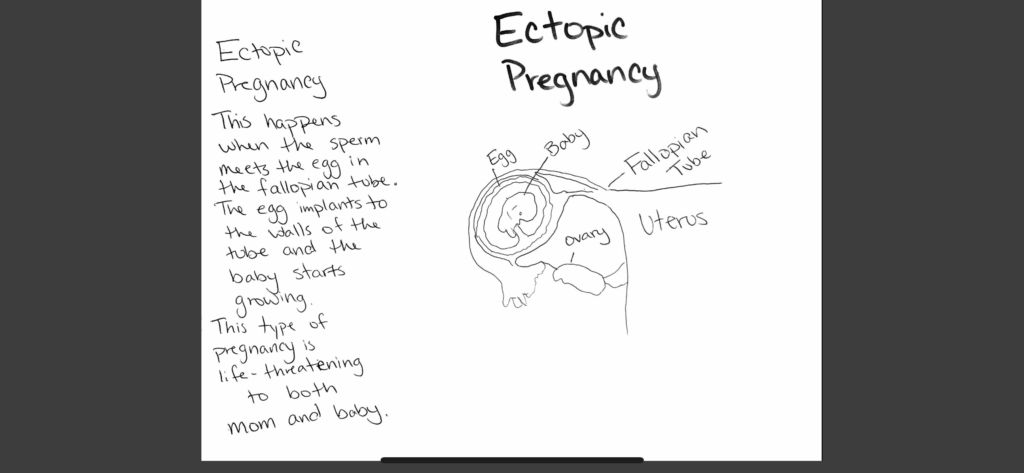


For this semester’s STEAM project, I wanted to talk about pregnancy and ectopic pregnancies. We start with the uterus. Within the uterus, there is the cervix which is the canal between the uterus and the vagina. There is the fallopian tube which is the tube that the egg travels through to get to the uterus. The ovary is where the eggs are held and released from. The sperm is made of three pieces. There is the head, midpiece, and the tail. After sexual intercourse, the sperm is released from the penis and enters the vagina. From there the sperm travels through the cervix and into the uterus. If it is during a woman’s ovulation cycle, the egg has dropped into the uterus and the sperm can reach the egg. If sperm is released before ovulation cycle, sperm will sit in the uterus and after approximately 5 days, the sperm will disintegrate and is washed out. In some cases, the sperm will enter the fallopian tube where the egg is traveling and enter the egg there. Once the egg is fertilized, it travels to the uterus and implants to the uterus wall and begins to grow. If the egg does not make it to the uterus it can implant to the wall of the fallopian tube.
An ectopic pregnancy is when a pregnancy occurs outside of the uterus. About 90 percent of ectopic pregnancies happen in the fallopian tube. Ectopic pregnancies occur in about one and 50 pregnancies. A tubal ectopic pregnancy can occur because the fallopian tube can be deformed, damaged, or inflamed. If any of those occur, the egg can be blocked and begin to grow and attach to the wall of the tube. The symptoms for an tubal ectopic pregnancy are similar to a normal pregnancy but as the baby grows, the symptoms may change. The risk factors that can cause ectopic pregnancies are sexually transmitted infections that cause inflammation in the fallopian tubes. Fertility treatments can cause problems with the fallopian tubes. Infertility is a problem amongst itself but the treatment IVF used can cause additional problems. A certain type of birth control can cause issues. An IUD (intrauterine device) is inserted into the uterus. If a pregnancy occurs while the IUD is inside the uterus, this can lead to a tubal pregnancy. With a tubal ectopic pregnancy, there is a chance for a ruptured fallopian tube. The signs and symptoms of an ectopic pregnancy are pelvic pain and vaginal bleeding.
When diagnosing an ectopic pregnancy, it is to have a pelvic exam and an ultrasound. The treatment for a tubal ectopic pregnancy is a surgery to remove the egg. Laparoscopic surgery is when a small thin incision is made on the abdomen and a tube is inserted into the abdomen. This tube is equipped with a camera so that the surgeon can see the uterus and oviducts. The surgeon can remove the egg. If there is any damage to the oviduct (where the egg passes from the ovary), the surgeon will also remove it. Any ectopic pregnancy is extremely dangerous for both the mom and the baby and when diagnosed as soon as possible. The earlier the pregnancy is located the better chance for the women to still have a normal pregnancy in the future.

Abigails project is a poster that details how an ectopic pregnancy begins, and works. Within her poster she has drawn four separate images. The first image displays the anatomy of both the uterus, and a sperm cell. An ectopic pregnancy is a pregnancy that occurs outside of the uterus, typically in the fallopian tubes. This type of pregnancy can occur due to the fallopian tubes being deformed, damaged, or inflamed. This can cause the egg to be blocked, and cause it to attach to the walls of the fallopian tubes. Fertility treatment drugs, and the birth control IUD are some of the things that can cause damage to the fallopian tubes in-turn causing an ectopic pregnancy. In order to diagnose an ectopic pregnancy a pelvic exam an ultrasound must be done. Once diagnosed the treatment for a tubal ectopic pregnancy requires laparoscopic surgery through the abdomen to remove the pregnancy from the fallopian tubes. An ectopic pregnancy is extremely dangerous for the woman, and needs to be diagnosed as soon as possible. The earlier the diagnosis the better chance of no harm being done to the womens reproductive system, and a better chance for normal conception and pregnancy in the future.
Overall I feel that Abigails poster explains very clearly what she is trying to portray from her essay. I think she uses just the right amount of literal, while also incorporating art work. She also goes into a more in depth explanation in her last illustration. Overall I think this is a well done project!